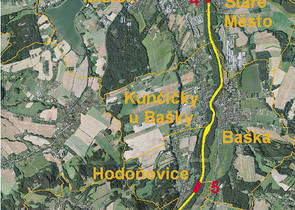Nature Conservation 6/2013 — 27. 1. 2014 — Nature and Landscape Management — Print article in pdf
Klečková L. & Birklen P.: Threatened Gravel Habitat Management in the Ostravice Site of European Imp

Gravel bars deposited by fast flowing uncanalized water courses are among the globally most threatened habitats.
In the Czech Republic, gravel alluvium can be found in variously preserved remnants, particularly along rivers in the Moravskoslezské Beskydy/Moravian-Silesian Beskids Mts. and in their foothills (northern Moravia). In the 20thcentury, gravel floodplain deposits dramatically disappeared due to water course canalization which had damaged the hydrological regime of rivers, being necessary for erosion and gravel deposit accumulation. The fact should be taken into account when proposing the appropriate management which has to seek compromises between nature conservation interests and water management ones. For a pilot project trying to find possible solutions, the Ostravice Site of European Importance (SEI, pursuant to Act No. 114/1992 Gazette on Nature Conservation and Landscape Protection, as amended later, the term for Site of Community Importance, SCI under the European Union’s Habitats Directive) was selected. The river was heavily affected by canalization but moreover, it has been to a limited extent keeping the character of a watercourse producing gravel floodplain deposits. To stimulate natural flood flow, the selected deposits were artificially removed. During five consecutive years, mostly natural succession was monitored at the sites. At the same time, the critically threatened Coastal small reed (Calamagrostis pseudophragmites) was in detail mapped and its ecology studied: the grass species indicates the occurrence of the Tussilaginii-Calamagrostietum association, for which the SEI had been established. The research revealed that, for the disturbed bar-forming water course dynamics, the management measures proposed are fully appropriate to preserve the above plant association, respecting of its ecological requirements. In addition water management functions of the improved river bed, necessary for the site development, will be also maintained. The project funded by the Ministry of the Environment of the Czech Republic was carried out by the Silva Tarouca Research Institute for Landscape and Ornamental Gardening Průhonice near Prague in cooperation with the Nature Conservation Agency of the Czech Republic Ostrava Regional Branch and University of Ostrava.

